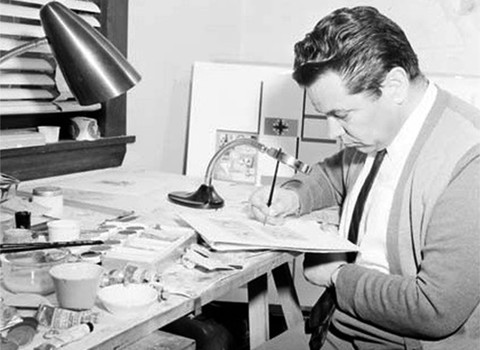Source: Diners Club Magazine 1970.
Every reader of Signature has seen some of George Hamori’s designs but his name is probably known only to very few. This quiet, shy and very modest Hungarian has designed some of our most attractive postage stamps as well as those of many other countries. As a designer, his work is not confined to this tiny format but this is certainly the most unusual aspect of his work and probably,the most interesting. Dark, chunky and blunt featured, George Hamori looks a little like his famous compatriot, Arthur Koestler or perhaps just like every other very dark, stocky Hungarian. He speaks excellent English with a strong accent and seems singularly free of all “arty” poses.
He dresses in either a quiet business suit, or a shirt and shorts when it is warm in the studio attached to his Bellevue Hill home. He is married and has a fifteen year old daughter Annette who was born in Israel and who is, according to her proud father, “very good at drawing”.
Born in 1918, George left Hungary in 1949 when the communist grip on his country made it obvious that the regime was there to stay. He travelled all over Europe, studying design in Austria, Germany, Italy, France and England, and finally to Israel and it was there that he met the head of the stamp printing branch of the Israeli Post Office and became interested in the very difficult and demanding work of stamp design.
“Everything I know about stamp design,” he says, “I learnt there.” In fact, George Hamori designed very many of Israel’s early stamps-stamps that have now become classics among collectors, not only because they have become valuable, but also because of the general originality and excellence of their design. While he was still working in Israel, one of George’s submitted designs won first prize in an international competition held by the United Nations for a UNESCO stamp.
Since that time, he has designed many U.N. stamps and has won six 1st prizes, four 2nd prizes and eight 3rd prizes for U.N. stamp designs. Israel is a small country and the opportunities for work in design were rather limited at that time, so once again George Hamori set out on his travels and decided to settle in Sydney. He arrived at 6 p.m. one Saturday in October 1956 and by Monday he had managed to obtain several commissions for work from Qantas.
Since then, he has worked constantly for Qantas, designing booklets, menus and other publicity brochures for Australia’s National Airline. He has won three first prizes in graphic design awards for his covers for Qantas annual reports. Another of his early commissions was from the Reserve Bank of Australia and he has been doing superb work for them ever since, graphic designs that are notable for their economy, simplicity and elegance. He works too for the Commonwealth Banking Corporation of Australia and for Esso among others.
It is in the field of stamp design that this hard working graphic artist has achieved the most enduring place in the life of this country, though it took a little while for him to gain recognition. He won a competition offered by the Australian Postal Department, who called for designs for the Commonwealth Games to be held in Perth in 1962. George’s design was chosen for the 2/3 value and it still remains one of our best stamps. The following year, he designed a stamp commemorating the Centenary of the Red Cross and this was also used for the Papua & New Guinea stamp issued at the same time.
His designs since then have included the 1965 Centenary of International Telecommunication Union, the 50th, Anniversary of the death of Sir Lawrence Hargrave in the same year, the 1968 and 1969 Christmas stamps, the 1969 I.L.O. stamp and the 1970 stamps issued to mark the 50th anniversary of the establishment of Qantas Airways. He has designed many of the stamps of Papua New Guinea including a superb set of stamps in 1969.
